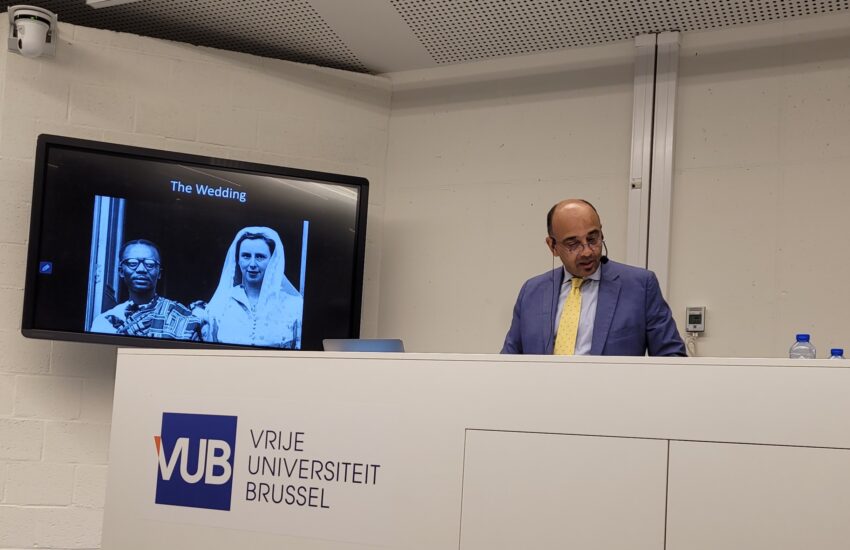Afropean Music: A Swedish Soul Classic
This weekend the Scandinavia Show came to London’s Tobacco Dock in Wapping, and being a bit of a Scandophile I decided to pop along to feed my enthusiasm (mainly by eating a shed load of Swedish meatballs covered in lingonberries).
I perused stalls that celebrated everything from clever furniture to the Aura Borealis, and watched beautiful blonde women perform a mildly risque fitness demonstration; all the things one usually associates with Scandinavia. But the show reminded me why I set up this blog all about black Europe, a side of the continent that rarely seems to get a mention in the national identities that get exported. There was nothing to suggest any multiculturalism at the show- nothing of Denmark’s large Somalian community or Rinkeby, the area of Stockholm with a demographic that is around 90% Muslim.

Image by Johny Pitts ©
There was something, though, which reminded me (even though the connection is a little tenuous) of a Swedish- Jamaican soul singer I’ve long been a fan of. I came across a stall selling some Danish candles called Hygge and on the packaging there was a piece of writing describing their popularity in Nordic countries.
“[The people of Scandinavia…] create intimacy, fellowship and conviviality around everyday moments. The kind of everyday moments borne from the region’s exposure to extended cold and darkness and the need for people to come together, over centuries, around a source of heat and light…It’s their ability to turn this rather functional need into an almost spiritual experience…with friends and family around the illuminating glow of the flickering candle flame to create what neighbouring Sweden calls ‘Mys’”
Stockholm is one of my favourite Scandinavian cities, I visit it at least once a year and nearly always go during the winter where I sense, in the flickering candles behind the frosted windows and the cosy little bars and cafes that are cocoons, this feeling of Mys; of warmth, comfort and relaxation despite the minus zero temperatures outside. I’m constantly struck by how the Swedes find beauty in the cold and the darkness, figuratively and literally, because there is no doubt that a lack of sunlight during the winter months can bring one closer to melancholy, too.

© 2006 Johny Pitts
All this mys and melancholy can be found on the 1997 debut album of Swedish soul artist Stephen Simmonds entitled, simply, Alone (repackaged and remixed as ‘Spirit Tales’ in the UK and US). Simmonds’ father was a Jamaican musician who, like many black musicians during the 60’s and 70’s, found a home in relatively liberal jazz-loving Sweden. Simmonds’ foundations for the album are undoubtedly the spirituality of Bob Marley, the politics of Marvin Gaye, and the soul stylings of Stevie Wonder, along with the odd Jazz inflection here and there- all influences his Dad brought from across the seas. There are also contemporary comparisons from America to be made, that range from Eric Benet to D’Angelo and, as the US and UK record labels were blatantly trying to exploit, Maxwell. Indeed, Stephen Simmonds came along in the fine tradition of what Kedar Massenberg coined neo-soul, a musical movement formed by the latter part of a Generation X who came of age in the 1990’s, and were responding to all the 60’s and 70’s soul artists that were played to them as children. Simmonds was also part of a golden generation of black music coming out of Scandinavia that included Neneh and Eagle Eye Cherry, Blacknuss, Danish super producers Soulshock and Karlin, Robyn, Jennifer Brown and Titiyo.
Whilst he found success in Sweden, the album faltered in The States, and I think it is because Alone is not quick music. I remember buying it, listening once and forgetting about it for a while. The album doesn’t have any ‘bangers’ that jump out and demand your attention. Much like the Hygge candles I mentioned earlier, it is a slow-burner, with whispery vocals that flicker upon warm cinematic chords. I say flicker because there is space- the music is quiet and moody and capacious with an emphasis on the rich low-end.

I actually gave my copy of ‘Alone’ to a friend, who was more patient than I, and ended up encouraging me to give it another chance. I would play the album in the background when I was writing or cooking or doing anything but consciously listening. Slowly but surely the melodies and the lyrics began to marinate, and today Alone ranks as one of my favourite albums of the last 20 years. The more you listen, the more the wonderful subtleties appear, and I’m still hearing new things after more than a decade of playing it, like the use of a rainstick on the jazzy ‘Let it Go’ or the whispers on the moody title track ‘Alone’, that I eventually realised were spoken in Swedish. You begin to hear Sweden as an influence all over the album; the late Swedish Jazz legend ‘Esbjorn Svensson’ playing on ‘Tears Never Dry’, Neneh Cherry’s half sister Titiyo providing backing vocals on ‘Hope You Do’, the production of Swedish film maker Peter Cartriers, who no doubt contributed to the atmospheric sound of the album. I might even suggest Simmonds was responding to growing up as part of Stockholm’s first-generation mixed-race community, and themes of loneliness and alienation permeate throughout lyrically.
“It’s so hard to live alone, I’ve got no place to call my home” – Stephen Simmonds ‘Alone’

© Photo by Rick Guest, art direction by Mat Cook
There is another Swedish word that I hear in Stephen’s music that doesn’t have an exact translation into English. I say ‘word’, but I see it more as a kind of understated philosophy which, along with the Law of Jante, underpins much of the country’s national identity, particularly when it comes to art and design. The word is lagom.
The best description I have found of lagom in English is ‘enough is as good as a feast’, that is; anything superfluous to what is necessary to reach a desired result doesn’t need to be there, and Alone distinguishes itself from the plethora of American soul artists at the time because of the restraint and minimalism of the album. There are no caterwauling adlibs, no self indulgent piano solos, (despite Simmonds’ being an accomplished pianist) and none of the lover-man spoken word intros many of his contemporaries were guilty of (you know, all that “Listen baby, tonight you’re gonna have the night of your life” type stuff).
‘Alone’ is an album that invites one to sit and listen and conjures up imagery of winter, yet warmth and of loneliness, yet optimism. It is melancholy though deeply spiritual.
So as winter begins to set in, why not take a Fika, burn a candle, and have a listen to one of the most underrated soul albums of the last twenty years. You never know, you might even feel some of that Swedish Mys.
http://www.stephensimmonds.se/webshop.php
Post cover image by Rick Guest, Art Direction by Mat Cook



Thank you for introducing his music to me!